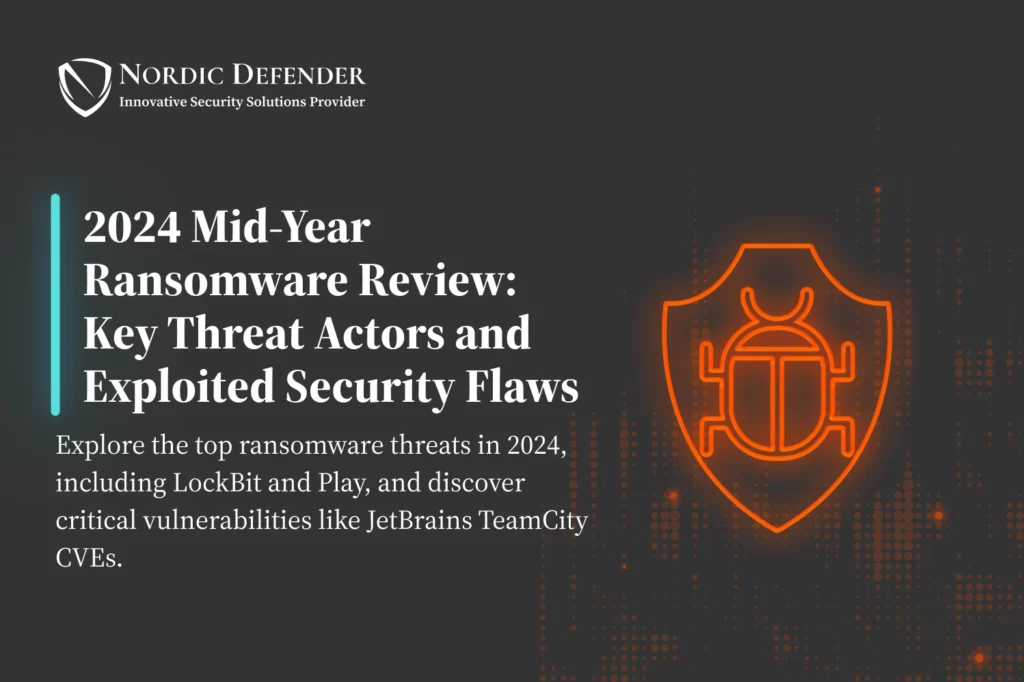As we dive into 2024, the cybersecurity landscape continues to evolve, with ransomware remaining one of the most prevalent threats to organizations worldwide. In the first half of this year, there was a noticeable uptick in ransomware attacks, highlighting the persistence of well-established groups like LockBit, Play, and 8Base, while also marking the emergence of newer players. Organizations across Europe, particularly in Sweden, must stay informed on the most frequently exploited vulnerabilities to safeguard against potential breaches.
The Rise in Ransomware Activity
According to recent data, ransomware incidents increased by 4.3% year-over-year during the first half of 2024, signaling the aggressive nature of ransomware groups in targeting vulnerable systems. LockBit remains the most active, contributing to a large portion of these attacks. Additionally, Play, 8Base, BlackBasta, and Medusa have all been involved in high-profile incidents. One critical trend is the shift from purely financial targets to a broader range of sectors, including healthcare, education, and government agencies. Attackers are exploiting weak points in network infrastructure and software vulnerabilities, causing widespread damage that impacts not only the targeted organization but also its customers and stakeholders.
These ransomware groups primarily gain access by taking advantage of unpatched systems or through social engineering techniques like phishing. Once inside the network, the attackers encrypt critical data, often demanding hefty ransoms in cryptocurrency for its safe return. As such, it’s vital for organizations to enhance both their technical defenses and their employee awareness programs to reduce the likelihood of being targeted.
Most Common Vulnerabilities Targeted by Ransomware in 2024
Several vulnerabilities have been exploited repeatedly by ransomware groups, primarily because they remain unpatched in many systems, despite known fixes. Below are some of the top CVEs that have been targeted this year, which businesses should prioritize addressing immediately:
ConnectWise ScreenConnect (CVE-2024-1709)
The CVE-2024-1709 vulnerability, affecting the widely used remote access tool, allows attackers to execute arbitrary code remotely. Given the increasing reliance on remote work tools, particularly since the pandemic, ransomware groups have been actively exploiting flaws like this. Businesses should ensure that they are running the latest versions of such tools and have applied the necessary patches.
JetBrains TeamCity (CVE-2024-27198)
Used by software developers for continuous integration and deployment (CI/CD), TeamCity’s CVE-2024-27198 vulnerability could be exploited by attackers to execute code or access sensitive developer environments. Since many organizations rely on this software for managing codebases, the compromise of a CI/CD pipeline can have devastating effects, potentially giving attackers backdoor access to an entire organization’s systems.
PHP CGI Remote Code Execution (CVE-2024-4577)
This particular vulnerability, CVE-2024-4577, in PHP’s CGI implementation allows an attacker to execute arbitrary code on a web server. Since PHP is a widely used programming language, this vulnerability presents a significant risk to web applications and their underlying infrastructure. Organizations should ensure that PHP installations are regularly updated to prevent exploitation.
New Ransomware Groups on the Horizon
In addition to familiar ransomware groups, new players have emerged, further complicating the threat landscape. RansomHub, DragonForce, and LukaLocker are just a few of the latest entrants, each bringing their own methods of exploitation and encryption. These groups often adapt quickly to evade detection, using sophisticated techniques to bypass traditional security measures. For instance, some newer ransomware strains have begun incorporating advanced data exfiltration methods, holding data hostage while threatening public leaks if ransom demands are not met.
Key Recommendations for Businesses in Sweden and Beyond
For businesses in Sweden, where cybersecurity laws are tightening in response to increasing threats, it’s vital to adopt a proactive stance against ransomware. Here are some key recommendations:
- Patch Management: Implement a rigorous patch management process to ensure that all known vulnerabilities, such as those listed above, are addressed promptly. Regular vulnerability scanning and automatic patching can drastically reduce the risk of exploitation.
- Employee Training: Human error remains one of the weakest links in cybersecurity. Implement regular training sessions to help staff recognize phishing attempts and other social engineering tactics used by ransomware groups.
- Backup Solutions: Invest in robust data backup and recovery solutions. Regular backups ensure that even in the event of a ransomware attack, critical data can be restored without paying a ransom.
- Endpoint Security: Strengthen endpoint security with updated antivirus software, intrusion detection systems, and advanced threat protection. Having layered security defenses in place is crucial to stopping attackers before they infiltrate deeper into your network.
- Incident Response Plan: Develop and regularly update an incident response plan. In the event of an attack, having a well-defined plan helps ensure a quick, coordinated response, minimizing damage and downtime.
Conclusion
The ransomware landscape continues to evolve, with attackers becoming more resourceful and relentless in their pursuit of vulnerable systems. While 2024 has seen a rise in attacks, organizations can take proactive measures to defend themselves. Addressing the vulnerabilities that threat actors are known to exploit, such as those in ConnectWise, JetBrains, PHP, and Windows services, should be a top priority for cybersecurity teams. By adopting a multi-layered defense strategy that includes up-to-date software patches, employee training, and comprehensive backup solutions, businesses can greatly reduce the likelihood of falling victim to ransomware.
Stay informed, stay secure, and make cybersecurity a core focus in 2024.
